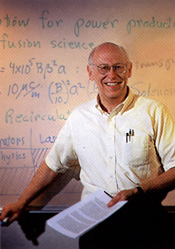 |
|
Roger Bangerter
|
Roger Bangerter, head of Berkeley Lab's fusion energy research program since 1990, was at one time pointed in the direction of a career in particle physics. Then came the OPEC oil embargo in 1973 and his career took a major turn.
After earning his bachelor's degree in physics from the University of his native Utah, Bangerter came to Berkeley to get his doctorate in high-energy physics from the University of California. He received his Ph.D. as a member of the particle physics group of Luis Alvarez, at what was then known as the Lawrence Radiation Laboratory. He remained with the Alvarez group for another five years. Then came the long lines at the gas pumps and the realization that an energy crisis loomed for future generations. Bangerter wanted to make a contribution, and fusion, he decided, was the way to go.
"I have faith that fusion energy will work and that it is our best hope for solving the world's energy problems," he says. "Even though it is a technical challenge, whether you're talking about inertial or magnetic confinement, fusion is as good a prospect as any other alternative to fossil fuels."
While with the Alvarez group, Bangerter had been assigned to design a couple of accelerator beamlines, including one at Berkeley's powerful Bevatron. Though incidental to his work in particle physics, the assignments proved fortuitous, putting him in a unique position to apply accelerator technology to inertial fusion research.
Bangerter's career in fusion research has taken him on a round-trip tour of the UC-managed national laboratories. From Berkeley, he went, in 1974, to Lawrence Livermore National Lab (LLNL) where he spent seven years heading up program in charged particle inertial fusion. He then went to Los Alamos National Lab, where for three years he coordinated the national heavy ion fusion program. During that time, he was also program manager for target design.
Bangerter returned to Livermore in 1984 to serve as deputy director of X-Division, which is LLNL's inertial confinement fusion theory division. In the six years of his second stint at Livermore, he also headed up special projects that were charged with advancing inertial fusion concepts and applications for commercial power production.
"I have been fortunate to have been in the right place at the right time throughout my career," Bangerter says. The right place and time for him today is Berkeley Lab.
Return to the Magazine's Table of Contents.

